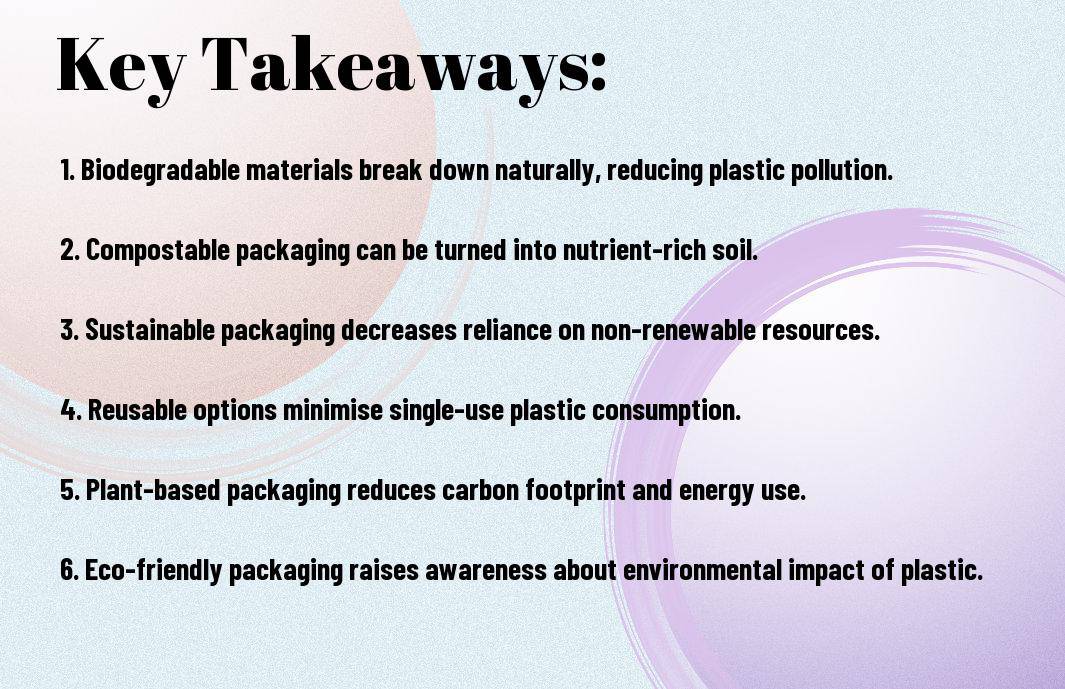Embracing eco-friendly food packaging is not just a matter of personal choice, it is a crucial step towards reducing the harmful impact of plastic waste on the environment. By opting for sustainable packaging options, you can significantly contribute to the reduction of plastic pollution, helping to protect our oceans, wildlife, and ecosystems. In this blog post, we will explore the environmental benefits of eco-friendly food packaging and how you can make a positive impact through simple, everyday choices.
Key Takeaways:
- Eco-friendly food packaging is made from sustainable materials and is biodegradable, reducing the amount of plastic waste that ends up in landfills and oceans.
- Biodegradable packaging breaks down over time, reducing environmental harm, and promoting a more circular economy, where resources are reused and recycled rather than disposed of.
- Choosing eco-friendly packaging for food products can encourage a shift towards more sustainable practices in the food industry, leading to a reduction in overall plastic waste and a healthier planet for future generations.

Environmental Impact of Food Packaging
When it comes to food packaging, the environmental impact cannot be overlooked. The way we package our food has a direct effect on the environment, particularly in relation to the growing issue of plastic waste. According to a post on Meyers, packaging design plays a crucial role in addressing the plastic waste crisis. In this chapter, we will delve deeper into the environmental impact of food packaging and how eco-friendly alternatives can help combat plastic waste.
Effects of plastic food packaging on Environment
Plastic food packaging has significantly contributed to the environmental crisis we face today. The production of plastic packaging releases harmful pollutants into the air, water, and soil, posing serious threats to the ecosystems. Furthermore, the disposal of plastic packaging leads to the accumulation of non-biodegradable waste, impacting wildlife and marine life. Plastic pollution is a pressing issue that requires immediate attention, and addressing the environmental effects of plastic food packaging is crucial in mitigating the damage.
Role of Eco-friendly packaging in minimizing plastic waste
Switching to eco-friendly packaging presents a sustainable solution in minimising plastic waste. These alternatives are often biodegradable, compostable, or recyclable, reducing the burden of non-biodegradable waste on the environment. By opting for eco-friendly packaging, you can actively contribute to reducing your carbon footprint and mitigating the environmental impact of food packaging. Choosing sustainable packaging options not only helps in waste reduction but also sets a precedent for responsible consumption and environmental stewardship.
Types and Advantages of Eco-Friendly Food Packaging
When it comes to eco-friendly food packaging, there are various types available, each with its own unique advantages. By opting for these sustainable packaging options, you can significantly reduce the amount of plastic waste produced. Here are some popular types of eco-friendly food packaging and the benefits they offer:
| Type | Advantages |
| Biodegradable Packaging | Breaks down naturally, reducing landfill waste |
| Compostable Packaging | Can be broken down into organic matter, reducing environmental impact |
| Recycled Content Packaging | Reduces the need for virgin materials, lowering energy consumption |
| Reusable Packaging | Can be used multiple times, minimising single-use waste |
| Plant-Based Packaging | Derived from renewable resources, reducing reliance on fossil fuels |
Description of Eco-Friendly Food Packaging Materials
When it comes to eco-friendly food packaging, materials like biodegradable plastics, compostable paper, and plant-based polymers are popular choices. These materials are designed to break down or be repurposed after use, reducing their impact on the environment. By opting for sustainable materials, you can significantly reduce your ecological footprint.
Benefits of Using Eco-Friendly Food Packaging
By choosing eco-friendly food packaging, you not only contribute to reducing plastic waste, but you also help in conserving natural resources, reducing pollution, and minimising your impact on the environment. Additionally, sustainable packaging options often appeal to environmentally conscious consumers, giving your brand a competitive edge in the market. After all, making the switch to eco-friendly packaging is not just beneficial for the planet but for your business as well.
Challenges and Solutions in Eco-Friendly Food Packaging
When it comes to eco-friendly food packaging, there are various challenges to overcome, as well as solutions to implement. It is important to be aware of these factors in order to effectively reduce plastic waste and promote sustainable packaging options.
Barriers in Implementing Eco-Friendly Food Packaging
One of the main barriers in implementing eco-friendly food packaging is the cost factor. Sustainable packaging materials often come at a higher price compared to traditional plastic packaging. Additionally, there may be limited availability of eco-friendly options, making it challenging for businesses to switch to more sustainable alternatives.
Possible Solutions to promote Eco-Friendly Food Packaging
Despite the barriers, there are several solutions that can be implemented to promote eco-friendly food packaging. This includes investing in research and innovation to develop cost-effective sustainable packaging materials. Additionally, support from consumers and government policies can play a significant role in driving the demand for eco-friendly packaging, leading to more widespread availability and affordability.
Case Studies of Eco-Friendly Food Packaging
When it comes to reducing plastic waste in the food packaging industry, there are several case studies that demonstrate the effectiveness of eco-friendly packaging. Here are a few examples:
- Case Study 1: A bakery in London reduced their plastic waste by 40% by switching to compostable packaging made from plant-based materials.
- Case Study 2: A supermarket chain in Manchester implemented a reusable packaging system for fresh produce, resulting in a 50% reduction in plastic usage.
- Case Study 3: A fast-food restaurant in Birmingham introduced biodegradable containers for takeout meals, leading to a 60% decrease in single-use plastic waste.
Success Stories of businesses using Eco-Friendly Food Packaging
Many businesses have successfully adopted eco-friendly food packaging and have seen positive results. By making the switch to sustainable packaging materials, these companies have not only reduced their environmental impact, but have also gained a competitive edge in the market. Customers are increasingly seeking out eco-friendly options, and businesses that embrace sustainable practices are reaping the rewards in terms of brand reputation and customer loyalty.
Lessons from Eco-Friendly Food Packaging Innovations
One of the key lessons from eco-friendly food packaging innovations is that sustainable practices can be economically viable for businesses. While initial investments may be required to transition to eco-friendly packaging, the long-term cost savings and positive impact on consumer perception can far outweigh the initial outlay. Additionally, businesses that lead the way in sustainability set an example for others in the industry and contribute to a positive shift towards more environmentally friendly practices.
Conclusion
From above, it is clear that eco-friendly food packaging plays a crucial role in reducing plastic waste. By using biodegradable and compostable materials, you can significantly decrease the amount of plastic entering landfills and oceans. Additionally, choosing packaging made from sustainable materials such as bamboo, sugarcane, or recycled paper can help lower your carbon footprint and contribute to a healthier environment. Making the switch to eco-friendly food packaging is an important step in the fight against plastic pollution, and it is a responsibility that we all share.
FAQ
Q: What is eco-friendly food packaging?
A: Eco-friendly food packaging refers to packaging materials that are biodegradable, compostable, or recyclable, and are designed to have minimal impact on the environment.
Q: How can eco-friendly food packaging help reduce plastic waste?
A: Eco-friendly food packaging helps reduce plastic waste by providing alternative packaging options that do not rely on non-biodegradable plastics, thus reducing the amount of plastic waste that ends up in landfills and oceans.
Q: What are some examples of eco-friendly food packaging materials?
A: Examples of eco-friendly food packaging materials include biodegradable plastics, compostable materials such as cornstarch-based packaging, and recyclable materials such as paper and cardboard.
Q: Are there any benefits to using eco-friendly food packaging beyond reducing plastic waste?
A: Yes, using eco-friendly food packaging can also help reduce the carbon footprint of packaging production, as well as promote a positive brand image for businesses that are committed to sustainability.
Q: How can businesses transition to using eco-friendly food packaging?
A: Businesses can transition to using eco-friendly food packaging by sourcing alternative packaging materials, educating consumers about the benefits of eco-friendly packaging, and implementing recycling programs to ensure that the packaging is disposed of responsibly.


